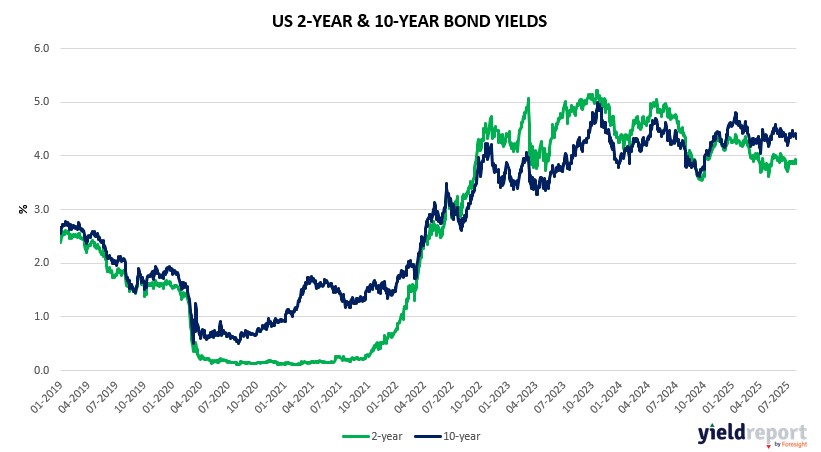| Close | Previous Close | Change | |
|---|---|---|---|
| Australian 3-year bond (%) | 3.362 | 3.43 | -0.068 |
| Australian 10-year bond (%) | 4.262 | 4.338 | -0.076 |
| Australian 30-year bond (%) | 4.975 | 5.052 | -0.077 |
| United States 2-year bond (%) | 3.867 | 3.918 | -0.051 |
| United States 10-year bond (%) | 4.322 | 4.394 | -0.072 |
| United States 30-year bond (%) | 4.8624 | 4.9337 | -0.0713 |
Overview of the Australian Bond Market
Australian government bond yields dipped slightly on July 30, 2025, as markets priced in the likelihood of RBA rate cuts following the softer-than-expected inflation data. The Australia 2-Year Bond Yield fell 3 basis points to 3.36%, while the 10-Year Yield (GTAUD10Y:GOV) dropped 5 basis points to 4.28%. The 15-Year Yield also eased 5 basis points to 4.64%, reflecting a broad decline in yields across maturities.
The inflation report, showing a Q2 CPI of 2.1% and a Trimmed Mean CPI of 2.7%, alleviated concerns about persistent price pressures, prompting bond traders to scale back expectations for prolonged high rates. Swap contracts now imply a high probability of an RBA rate cut as early as August, with markets anticipating a gradual easing cycle. This sentiment was bolstered by global developments, including a resilient US economy and ongoing US-China trade talks, which reduced uncertainty and supported demand for Australian bonds.
However, risks remain. President Trump’s tariff rhetoric, including potential levies on India and Russia, could stoke global inflationary pressures, potentially capping the decline in yields. Locally, the RBA’s upcoming August meeting will be pivotal, with investors seeking confirmation of the bank’s dovish tilt. Economists at HSBC and Morgan Stanley maintain a cautiously optimistic outlook, citing Australia’s stable economic fundamentals and the RBA’s data-dependent approach.
In the cash market, bond traders reported a slight increase in net long positions in Australian government bonds, particularly in the 5-year and 10-year tenors, as investors positioned for further yield declines. The Australian Treasury is expected to maintain current auction sizes for the August-to-October period, signaling steady debt issuance plans.

Overview of the US Bond Market
US Treasuries declined as Federal Reserve Chair Jerome Powell dimmed expectations for an interest-rate cut in September, urging patience in the face of a still-strong labor market and above-target inflation.
Yields on two-year notes, which are most sensitive to changes in monetary policy, settled seven basis points higher.
Federal Reserve Chair Jerome Powell said interest rates are in the right place to manage continued uncertainty around tariffs and inflation, tempering expectations for a rate cut in September.
“There are many, many uncertainties left to resolve,” Powell told reporters Wednesday following the central bank’s decision to once again keep rates unchanged. “It doesn’t feel like we are very close to the end of that process.”
The Federal Open Market Committee voted 9-2 to hold its benchmark federal funds rate in a range of 4.25%-4.5%, as it has at each of its meetings this year. Governors Christopher Waller and Michelle Bowman voted against the decision in favor of a quarter-point cut.
Traders pared back their expectations for rate cuts as Powell spoke. Interest-rate futures indicated roughly even odds on a reduction at the next meeting in September, down from about 60% earlier in the day.
In their post-meeting statement, officials downgraded their view of the US economy, saying “recent indicators suggest that growth of economic activity moderated in the first half of the year.” The Fed had previously characterized growth as expanding “at a solid pace.”
Data released Wednesday showed gross domestic product increased an annualized 3% in the second quarter after shrinking at a 0.5% rate in the previous period. The swing was caused largely by the front-loading of imports in the first quarter as companies moved to get ahead of tariffs. Consumer spending advanced at its slowest pace over consecutive quarters since the onset of the pandemic.
Inflation came in below estimates for a fifth straight month in June, though prices of some goods directly exposed to tariffs — including toys, apparel and electronics — jumped. Unemployment ticked lower to 4.1%, as the administration’s crackdown on immigration reduced labor supply.


